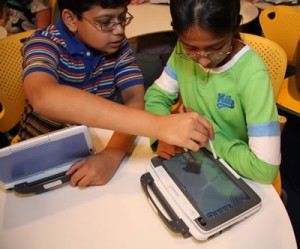
Intel’s newest Convertible Classmate PC design, unveiled April 26, gives elementary school students a chance to have “micro-mobility” as they move between individual, small-group, and whole-class activities, Intel says. The new Classmate portable computing device also includes improved energy efficiency and enhanced eReading capabilities.
Intel has joined forces with McGraw-Hill to include that company’s LEAD21—a new elementary school literacy program that offers students and teachers full print, digital, and professional development resources—on the new education technology device.
“Rich content and innovative applications bring the unique Classmate PC design to life, providing a complete solution that makes learning fun and teaching effective,” said Greg Pearson, vice president of the sales and marketing group and general manager of worldwide sales and operations for Intel.
Intel and McGraw-Hill conducted pilot programs over the last year to test how students and teachers engage with technology during classroom instruction, and they plan to continue their research to guide their efforts.
“Our ethnographers have spent countless hours understanding how technology can help school-age children here in the U.S. and around the world build the skills required for the future,” said Kapil Wadhera, acting general manager of Intel’s Emerging Markets Platform Group. “At Intel, we believe that education has the power to transform the lives of individuals, villages, cities, and nations, and we understand that technology is one of our greatest tools to advance education around the world.”
The new Classmate PC design features a touch screen with a user interface that is optimized for eReading applications; a water-resistant keyboard, touch pad, and screen; improved ruggedness, with the device having passed a drop test from desk height; bump and scratch-resistance surfaces and structures; and an optional anti-microbial keyboard. It can convert from laptop to tablet mode with a pivoting screen.
Additionally, the screen has a “palm rejection” feature that ignores the touch of hands resting on the screen, which allows students to write and draw intuitively, Intel said.
The Classmate PC was designed to be a complete eLearning device, said Intel ethnographer Tony Salvador.
“It enhances the experience for a student,” he said. “It’s more than just text. You can begin incorporating multimedia. In tablet mode it can be a [digital] reader, but the touch screen allows students to annotate and highlight.”
Today’s students don’t just consume materials, but produce them as well, and Salvador said the new Classmate PC allows them to do that effectively.
The computers are manufactured by a number of local selling partners, or original equipment manufacturers, and can be delivered to schools on a micro or macro level, Intel said.
Link:
- 3D equipment helps school lessons take on a whole new dimension - September 3, 2010
- IETF: AT&T’s net neutrality claim is ‘misleading’ - September 3, 2010
- To boost security, Facebook adds remote logout - September 3, 2010



Comments are closed.